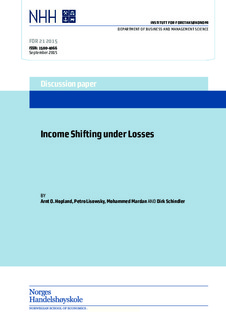| dc.description.abstract | This paper examines the flexibility of multinational firms to use income-shifting
strategies within a tax year to react to operating losses. We develop a theoretical
model that considers how affiliate losses can be adjusted ex post (i.e., after financial
outcomes are revealed) or ex ante (i.e., before financial outcomes are revealed) by
using transfer prices and internal debt. Our model predicts that under ex-post
income shifting, loss affiliates have lower transfer prices and internal leverage than
profitable affiliates, whereas under ex-ante income shifting, affiliates feature the
same transfer prices and internal capital structure, regardless of making losses.
Using data on direct transfer payments and internal debt of Norwegian affiliates,
we find empirical evidence that, under losses, transfer pricing provides flexibility
to adjust income shifting ex post, while we do not find evidence for flexibility in
the use of internal debt to shift income ex post. Our study extends prior literature
on income shifting that focuses largely on profitable firms and does not consider
transfer pricing and internal debt shifting concurrently. | nb_NO |
